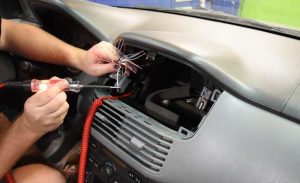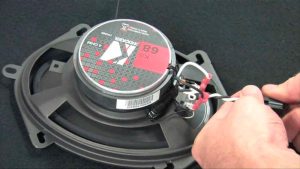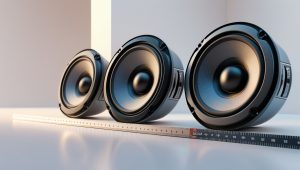Getting the perfect sound from your car stereo doesn’t always require expensive equipment. Often, proper adjustment of your existing system can dramatically improve your listening experience. This guide walks you through simple yet effective steps to optimize your car audio setup.
Contents
- Understanding Your Car Stereo System
- Finding the Right Starting Position
- Adjusting Basic Sound Controls
- Fine-Tuning with the Equalizer
- Addressing Common Sound Issues
- Advanced Adjustments for Audiophiles
- Optimizing for Different Music Genres
- Using Test Tracks for Precision Tuning
- Environmental Considerations
- Maintaining Optimal Sound
- When to Consider Upgrades
- The Final Touch: Trust Your Ears
- Conclusion
Understanding Your Car Stereo System
Before making adjustments, you need to understand the basic components of your car audio system:
- Head Unit: The control center of your audio system that handles input selection, volume control, and basic sound adjustments
- Equalizer (EQ): Allows you to adjust specific frequency ranges to match your preferences
- Amplifier: Boosts the audio signal before sending it to the speakers
- Speakers: Convert electrical signals into sound waves
- Subwoofer: Specialized speaker for low-frequency sounds
Each component plays a crucial role in delivering quality sound. Learning how they work together helps you make informed adjustments.
Finding the Right Starting Position
The first step in optimizing your car stereo involves establishing a baseline:
- Reset to factory settings: Clear any previous adjustments by returning to default settings
- Set all EQ bands to neutral: Position all frequency sliders at the center or “0” position
- Turn off any sound enhancement features: Disable bass boost, loudness, or virtual surround sound
- Set balance and fader to center: Ensure sound distribution is even throughout the vehicle
Starting with a clean slate prevents previous problematic settings from affecting your new adjustments.
Adjusting Basic Sound Controls
Once you’ve reset everything, begin with these fundamental adjustments:
Volume Level
Set your volume to about 70-75% of maximum. This range typically provides enough volume without distortion. Listen carefully for any crackling or fuzziness that might indicate you’re pushing the system too hard.
Bass and Treble
Start with modest adjustments to bass and treble:
- Bass: Increase gradually until you feel the low-end presence without overwhelming other frequencies
- Treble: Adjust until vocals and high-pitched instruments sound clear without becoming harsh
Remember that excessive bass can cause distortion and potentially damage speakers, while too much treble can create listening fatigue.
Balance and Fader
These controls determine sound distribution between speakers:
- Close your eyes and listen for the “center” of your sound
- Adjust balance (left/right) until the sound appears centered horizontally
- Adjust fader (front/back) based on your preferred listening position
- Fine-tune based on your vehicle’s acoustic properties
For solo drivers, you might prefer setting the sound stage slightly toward the driver’s side for a more immersive experience.
Fine-Tuning with the Equalizer
The equalizer is your most powerful tool for sound customization. Most car stereos offer at least a basic 3-band EQ, while premium systems might provide 7 or more bands.
Understanding Frequency Ranges
- Low frequencies (20-250 Hz): Bass drums, bass guitar, low piano notes
- Mid-low frequencies (250-500 Hz): Lower vocals, guitars, keyboards
- Midrange (500-2000 Hz): Vocals, most instruments
- Mid-high frequencies (2-4 kHz): Vocal clarity, instrument definition
- High frequencies (4-20 kHz): Cymbals, high-hat, air and sparkle
EQ Adjustment Strategy
Rather than boosting frequencies, try cutting problematic ones first:
- Play music you’re familiar with that covers a wide frequency range
- Identify any frequencies that sound muddy, harsh, or overwhelming
- Reduce those frequencies slightly (by 2-3 dB)
- Make small adjustments and listen for changes
- Give your ears time to adjust between changes
Common EQ adjustments include:
- Cutting around 200-300 Hz to reduce muddiness
- Slight boost around 1-2 kHz for vocal clarity
- Gentle cut around 3 kHz to reduce listening fatigue
- Subtle boost above 10 kHz for air and sparkle
Addressing Common Sound Issues
Boomy or Muddy Bass
If bass sounds undefined or overwhelming:
- Reduce frequencies between 125-250 Hz
- Ensure your subwoofer’s low-pass filter is set appropriately (usually around 80-100 Hz)
- Check subwoofer phase and polarity
Harsh or Sibilant Highs
For piercing high frequencies:
- Reduce the 3-6 kHz range
- Check speaker positioning and aim
- Consider adding sound dampening material to hard surfaces
Vocals Getting Lost
When vocals are unclear:
- Boost slightly around 1-2 kHz
- Cut competing frequencies in the 200-500 Hz range
- Adjust midrange frequency bands
Road Noise Interference
To combat road noise:
- Use the loudness feature at low volumes
- Consider sound insulation for your vehicle
- Slightly boost frequencies masked by typical road noise
Advanced Adjustments for Audiophiles
For those seeking the absolute best sound quality:
Time Alignment
If your system has time alignment capabilities:
- Measure the distance from your listening position to each speaker
- Enter these measurements into your head unit
- The system will delay closer speakers so all sound reaches you simultaneously
Crossover Settings
Proper crossover settings ensure each speaker handles appropriate frequencies:
- Set high-pass filters for smaller speakers (typically 80-100 Hz)
- Set low-pass filters for subwoofers (usually 80-100 Hz)
- Avoid frequency gaps or overlaps between speakers
Sound Stage Optimization
Create a realistic sound stage by:
- Positioning the perceived center of sound at eye level
- Adjusting the width to match your preferences
- Using slight delay settings if available
Optimizing for Different Music Genres
Different music styles benefit from different EQ settings:
Rock and Metal
- Moderate bass boost around 80-100 Hz
- Presence boost around 2-4 kHz for guitar clarity
- Controlled high end for cymbal definition
Hip-Hop and Electronic
- Enhanced sub-bass (30-80 Hz)
- Tight mid-bass around 100-200 Hz
- Clear highs for beat definition
Classical and Jazz
- Flat response with minimal EQ
- Subtle midrange emphasis for instrument clarity
- Extended high-frequency response for ambience
Podcasts and Audiobooks
- Reduced bass response
- Enhanced vocal presence (1-3 kHz)
- Reduced highest frequencies
Consider creating presets for different genres if your head unit supports this feature.
Using Test Tracks for Precision Tuning
Specific test tracks can help identify and fix sound issues:
Bass Test Tracks
Play songs with consistent, controlled bass lines to check for:
- Even bass response across frequencies
- Clarity without distortion
- Proper subwoofer integration
Vocal Test Tracks
Clear vocal recordings help you:
- Place vocals correctly in the sound stage
- Ensure natural tonality
- Check for sibilance issues
Dynamic Range Test
Tracks with both quiet and loud passages help:
- Verify system headroom
- Check for compression issues
- Ensure consistent sound quality at all volumes
Environmental Considerations
Your car’s interior significantly affects sound quality:
Material Reflections
- Hard surfaces create reflections and potential frequency peaks
- Soft materials absorb sound and can deaden the experience
- Find the right balance for your vehicle type
Ambient Noise
- Highway speeds create more low-frequency noise
- City driving introduces variable noise levels
- Adjust your system for your typical driving environment
Temperature Effects
- Extreme cold can make speakers stiff and less responsive
- High heat can affect electronic components
- Allow your system to reach normal operating temperature before critical listening
Maintaining Optimal Sound
Once you’ve achieved your ideal sound, maintain it with these practices:
Regular Cleaning
- Keep head unit controls and display clean
- Remove dust from speaker grilles
- Ensure good electrical connections
System Protection
- Avoid extreme volume levels that can damage components
- Protect equipment from temperature extremes
- Use surge protection when adding accessories
Periodic Re-evaluation
- Listen critically to your system monthly
- Make seasonal adjustments for changing driving conditions
- Refine settings as your preferences evolve
When to Consider Upgrades
While adjustments can dramatically improve sound, sometimes hardware limitations prevent achieving your desired sound quality. Consider upgrades when:
- You’ve optimized settings but still experience distortion
- Certain frequencies are completely absent despite adjustments
- Volume capabilities don’t meet your needs
- Factory speakers show signs of wear or damage
Focus on the weakest link in your system first—often the speakers provide the best improvement-to-cost ratio.
The Final Touch: Trust Your Ears
Despite all technical advice, your personal preference matters most. The “best” sound is subjective and depends on:
- Your musical preferences
- Your hearing sensitivity
- How you use your vehicle
- Your personal definition of good sound
Take time to enjoy the music between adjustments. Sometimes getting lost in the music reveals more about your system’s performance than active analysis.
Conclusion
Optimizing your car stereo doesn’t need to be complicated. Start with the basics, make gradual adjustments, and trust your ears. The perfect sound often comes from thoughtful tuning rather than expensive equipment.
By understanding each component’s role and how they work together, you can transform your driving experience into an immersive listening environment tailored specifically to your tastes. Whether you’re a casual listener or demanding audiophile, these adjustments will help you get the most from your car audio system.
Remember that perfect sound is a journey, not a destination. As you become more familiar with your system, you’ll discover new ways to refine and enhance your listening experience. Enjoy the ride!






